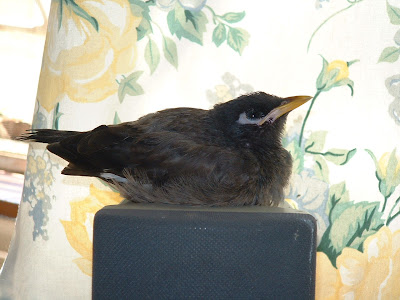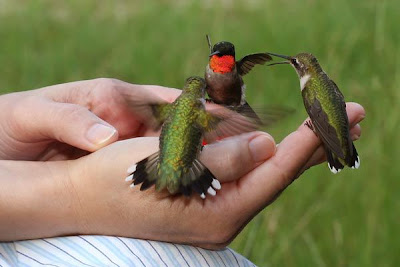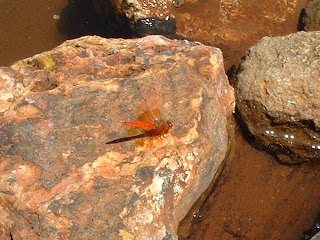"Little froglet in the water,don’tcha think you really aughtasave that croaking for tonightwhen you’re safely outta sight?Though I love your creaky choruspulsing through the springtime forest,how I hope a hovering hawkwill not end your earnest grok!Soon, I hope, a loving mate willcome to join you. I can’t wait tillall your fertile eggs are spread,safely in their waterbed."- Irene Brady, Nature WorksWell, Winter is in full swing here in South Africa now, and the songs of the frogs have been quietened by the chill and the frost. But I know they're still there, some buried deep under-ground, ready to fill the night with song once again as they sense the first Spring rains. I can virtually set my clock by their song, knowing that Spring and rain is in the air as soon as I hear their chorus.
In the meantime, life carries on at the pond. This water scorpion was sunning itself on the rocks on the end of the pond, and soon after he returned to the water, I was lucky enough to see him dragging an insect under-water for a quick feast.
These fascinating insects are commonly called water scorpions for their superficial resemblance to a scorpion, which is due to the raptorial forelegs and the presence of a long slender process at the posterior end of the abdomen, simulating a tail, which is actually a breathing tube - the tip of the tube is thrust above the surface of the water and air is conducted to the tracheae at the apex of the abdomen
They feed primarily on invertebrates, but occasionally take small fish or tadpoles.
The water scorpion emerging from the pond
The Water scorpion dragging an insect into his 'lair' under-water
The dragonflies are also still around, and I managed to get a shot of this fella sunning himself on the rocks.
A scarlet Dragonfly resting on a rock at the pond
A very welcome visitor to my garden is Molly, the Mole snake. She manages very nicely to keep the rat population at bay (they come for all the corn and sunflower seeds which I put out for the ducks and chickens) and, at 1.7m, she makes a formidable sight when upset. Mole snakes are completely harmless and non-venomous, but are fairly aggressive when threatened, even rearing up slightly, ready to strike if necessary. Here she surfaced from her hiding place one morning to see what all the raucous was about - we were busy cleaning out the pond and the workers were making quite a racket, chatting and clanging buckets as they emptied the water.
Molly, my resident Mole Snake, taking a peek at all the activity when we were cleaning out the pond.
(Click to enlarge for a better view of Molly)
Another welcome visitor to my garden is the Brown House Snake, also non-venomous and totally harmless and very soft-natured, trying to do a quick get-away when discovered, and also a great deterrent to rodents.
A not-so-welcome visitor is the Rinkhals (Spitting Cobra), who's venom is neurotoxic and partially cytotoxic. It is one of a group of cobras that has developed the ability to spit venom as a defense mechanism. It generally aims its venom at the face and if the venom enters the eyes, it causes great pain. Their average length is 90 - 110cm.
"Rinkhals" - watercolour on Moleskine 200gsm watercolour paper - Maree©
Nothing is ever killed or harmed in my garden, I don't even use insecticides (aphids on the roses are normally sprayed with a mean mixture of dishwashing liquid and tobacco, which seems to do the job, although I do make sure there are no lady bugs in the vicinity first). So, upon encountering this visitor, I normally don my glasses, race for a bucket and my snake hook and the unwelcome offender is duly captured, put in the bucket and then taken to an isolated dam some kilometers from us where he'll be safe against the threat of humans.
Roll on Spring,
you make your own statement, so loud and clear that the gardener seems to be only one of the instruments, not the composer!
















